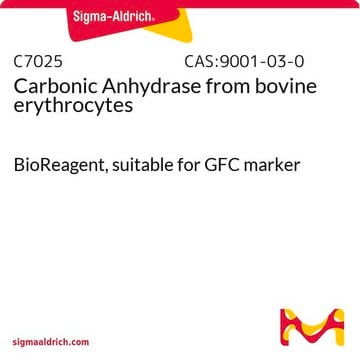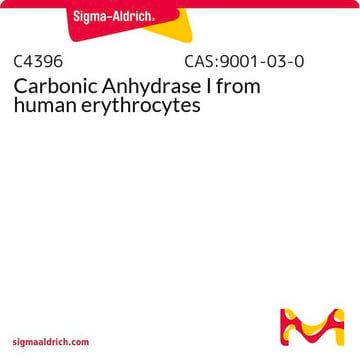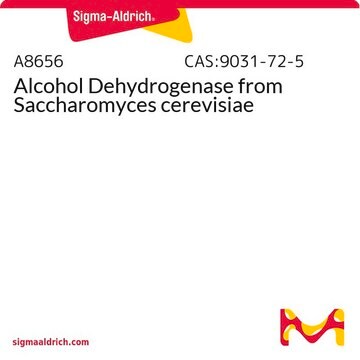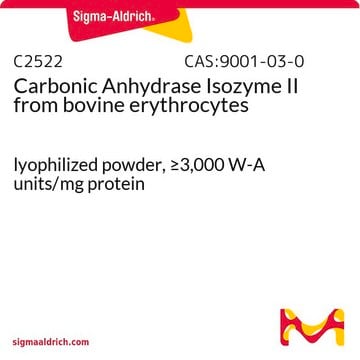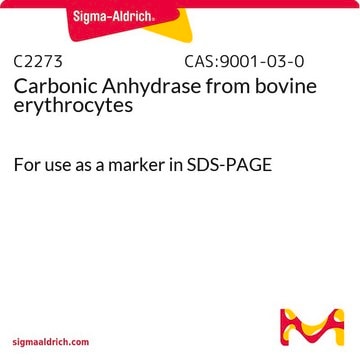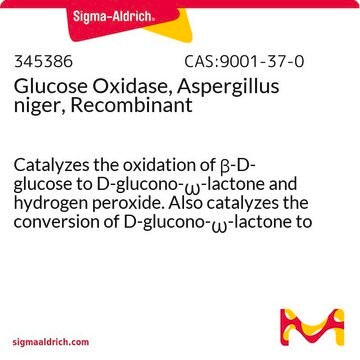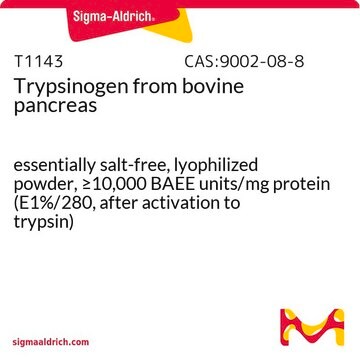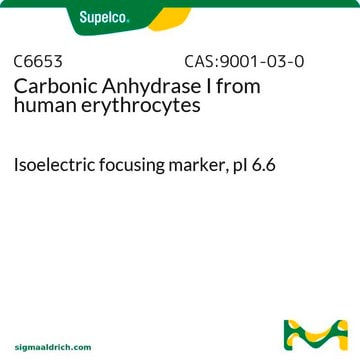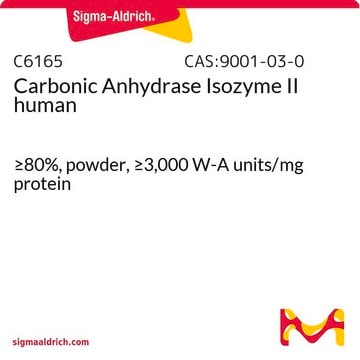The activity of this enzyme is established using a 0.02 M Tris buffer with a starting pH of 8.3 at 0°C. One unit will cause the pH of a 0.02 M Trizma buffer to drop from 8.3 to 6.3 per min at 0°C. However, the optimum pH and temperature is highly dependent on the specific application. There are a number of publications regarding the working parameters for this material. Please see the link below to review an example:
https://pubmed.ncbi.nlm.nih.gov/10701452/#:~:text=It%20was%20determined%20that%20the,61706%20Dalton%20by%20gel%20filtration.
C2624
Anhidrasa carbónica from bovine erythrocytes
≥95% (SDS-PAGE), specific activity ≥3,500 W-A units/mg protein, lyophilized powder
Sinónimos:
Carbonato deshidratasa, Carbonato hidrolasa
Seleccione un Tamaño
Seleccione un Tamaño
About This Item
Productos recomendados
origen biológico
bovine erythrocytes
Ensayo
≥75% protein basis (biuret)
≥95% (SDS-PAGE)
Formulario
lyophilized powder
actividad específica
≥3,500 W-A units/mg protein
solubilidad
deionized water: >10 mg/mL
temp. de almacenamiento
2-8°C
¿Está buscando productos similares? Visita Guía de comparación de productos
Aplicación
Acciones bioquímicas o fisiológicas
Definición de unidad
Palabra de señalización
Danger
Frases de peligro
Consejos de prudencia
Clasificaciones de peligro
Resp. Sens. 1
Código de clase de almacenamiento
11 - Combustible Solids
Clase de riesgo para el agua (WGK)
WGK 3
Punto de inflamabilidad (°F)
Not applicable
Punto de inflamabilidad (°C)
Not applicable
Elija entre una de las versiones más recientes:
Certificados de análisis (COA)
¿No ve la versión correcta?
Si necesita una versión concreta, puede buscar un certificado específico por el número de lote.
¿Ya tiene este producto?
Encuentre la documentación para los productos que ha comprado recientemente en la Biblioteca de documentos.
Los clientes también vieron
-
What is recommand usage temperature and pH range?
1 answer-
Helpful?
-
-
What is the recommended storage conditions for "Carbonic Anhydrase, from bovine erythrocytes?
1 answer-
The recommended storage conditions for Solution of Carbonic Anhydrase, from bovine erythrocytes may be frozen at –20 °C for future use. It is advised to avoid repeated freezing and thawing. Stock solutions may be dispensed into working aliquots, frozen, and then discarded after 2–3 uses.
Helpful?
-
-
What is the isozyme I or isozyme II of Carbonic Anhydrase from bovine erythrocytes (C2624 Carbonic Anhydrase)?
1 answer-
The product C2624, Carbonic Anhydrase from bovine erythrocytes, consists mainly of CA II. However, there are also small levels of CA I and CA IV present.
Helpful?
-
-
Is it possible to obtain information about the type of Carbonic Anhydrase (I or II) included in item C2624-carbonic anhydrase?
1 answer-
Product C2624, Carbonic Anhydrase from bovine erythrocytes, with a purity of ≥95% (SDS-PAGE), consists predominantly of CA II, with small levels of CA I and CA IV present.
Helpful?
-
Active Filters
Nuestro equipo de científicos tiene experiencia en todas las áreas de investigación: Ciencias de la vida, Ciencia de los materiales, Síntesis química, Cromatografía, Analítica y muchas otras.
Póngase en contacto con el Servicio técnico
